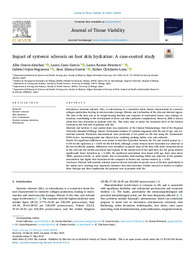Por favor, use este identificador para citar o enlazar este ítem:
https://hdl.handle.net/11000/37559Registro completo de metadatos
| Campo DC | Valor | Lengua/Idioma |
|---|---|---|
| dc.contributor.author | Gracia Sánchez, Alba | - |
| dc.contributor.author | García Cano, Laura | - |
| dc.contributor.author | Ramos-Petersen, Laura | - |
| dc.contributor.author | Gijon-Nogueron, Gabriel | - |
| dc.contributor.author | Zúnica García, Sara | - |
| dc.contributor.author | Chicharro-Luna, Esther | - |
| dc.contributor.other | Departamentos de la UMH::Ciencias del Comportamiento y salud | es_ES |
| dc.date.accessioned | 2025-09-29T11:07:38Z | - |
| dc.date.available | 2025-09-29T11:07:38Z | - |
| dc.date.created | 2025-08 | - |
| dc.identifier.citation | Journal of Tissue Viability, Volume 34, Issue 3, August 2025, 100929 | es_ES |
| dc.identifier.issn | 1876-4746 | - |
| dc.identifier.issn | 0965-206X | - |
| dc.identifier.uri | https://hdl.handle.net/11000/37559 | - |
| dc.description.abstract | Introduction: Systemic sclerosis (SSc), or scleroderma, is a connective tissue disease characterized by excessive collagen production, leading to microvascular damage, fibrosis, and dysfunction of the skin and internal organs. The skin of the foot, due to its weight-bearing function and exposure to mechanical forces, may undergo alterations, contributing to the development of ulcers and other podiatric complications. However, little is known about foot skin hydration in patients with SSc. This study aims to assess the hydration level of the stratum corneum in the foot skin of patients with SSc. Materials and methods: A case-control study was conducted at the Clinical Rheumatology Unit of the Regional University Hospital of M´alaga (Spain). Participants included 47 patients diagnosed with SSc and 52 age- and sexmatched controls. Hydration measurements were performed at ten points on the foot using the Corneometer 825® device. Sociodemographic and clinical data, including smoking habits, were also collected. Results: No significant differences were found in total foot hydration between the SSc and control groups (p = 0.254 for the right foot, p = 0.835 for the left foot), although a trend towards lower hydration was observed in the feet of affected patients. Differences were identified in specific areas of the foot, with lower hydration levels in the arch and the medial and lateral heel regions. In the medial arch of the right foot, the SSc group showed significantly lower hydration (p = 0.006). No significant associations were found with age, body mass index (BMI), physical activity, or water intake, but an association with smoking habits was observed in SSc patients; non-smokers had higher foot hydration levels compared to former and current smokers (p = 0.06). Conclusion: Patients with systemic sclerosis present reduced hydration in specific areas of the foot, particularly in the medial arch. Smoking may negatively influence foot skin hydration. Further research is needed to explore these findings and their implications for podiatric care in patients with SSc. | es_ES |
| dc.format | application/pdf | es_ES |
| dc.format.extent | 5 | es_ES |
| dc.language.iso | eng | es_ES |
| dc.publisher | Elsevier | es_ES |
| dc.rights | info:eu-repo/semantics/openAccess | es_ES |
| dc.rights | Attribution-NonCommercial-NoDerivatives 4.0 Internacional | * |
| dc.rights.uri | http://creativecommons.org/licenses/by-nc-nd/4.0/ | * |
| dc.subject | Systemic sclerosis | es_ES |
| dc.subject | Skin hydration | es_ES |
| dc.subject | Foot, corneometer | es_ES |
| dc.subject | Stratum corneum hydration | es_ES |
| dc.subject | Scleroderma | es_ES |
| dc.subject.other | CDU::6 - Ciencias aplicadas::61 - Medicina | es_ES |
| dc.title | Impact of systemic sclerosis on foot skin hydration: A case-control study | es_ES |
| dc.type | info:eu-repo/semantics/article | es_ES |
| dc.relation.publisherversion | https://doi.org/10.1016/j.jtv.2025.100929 | es_ES |

Ver/Abrir:
Impact of systemic sclerosis on foot skin hydration A case-control study.pdf
467,72 kB
Adobe PDF
Compartir:
 La licencia se describe como: Atribución-NonComercial-NoDerivada 4.0 Internacional.
La licencia se describe como: Atribución-NonComercial-NoDerivada 4.0 Internacional.
.png)